
MAY CONTAIN NUTS

Search Shorpy
SHORPY ART

Framed or unframed, desk size to sofa size, printed by us in Arizona and Alabama since 2007. Explore now.
Join and Share
Ad-Free Shorpy
Shorpy is funded by you. Patreon contributors get an ad-free experience.
Learn more.

Recent comments
- Party of Eight?
- Good choice
- Recent view
- Hudson’s Big Store
- Say what??
- Grapes?!
- Just a Great photograph.
- A Beautiful Moment
- Such joy
- Bethune-Cookman University today
- Yellow sky at morning
- Side Winder
- Air Quality?
- Sojourner Truth riot
- None were so blind(ed)
- The less famous sister
- Good ol' days?
- Rise and Fall
- Goo Goo Ga Joob
- Ticket Retention
- Not the only one
- Vagaries of War
- Killed by Amtrak
- Back to the Future
- Wanted --
- If you can't stand the light
- Centralized Traffic Control, I believe
- What's really happening
- Heckuva remote control!
- Sometimes — Things Go Bump!
Member Photos
The Shorpy
Print Emporium
Print Emporium
Search Shorpy
Search results -- 30 results per page
- Meet Me at the Fair: 1941
- ... 1941. View full size. 35mm Kodachrome transparency by Jack Delano.
nice If these ladies are from the circus, is the one on the ... Posted by Dave - 07/29/2012 - 5:57pm -
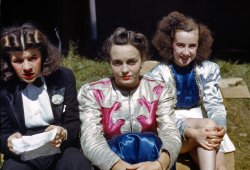
- Corn-Fed: 1941
- ... client near Castleton, Vermont." Medium format negative by Jack Delano for the Farm Security Administration. View full size.
Pursed ... Posted by Dave - 07/31/2019 - 8:34pm -
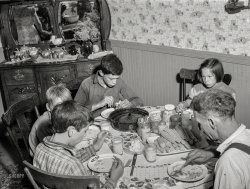
- Gonna Fly Now: 1941
- ... grounds. Caroline County, Virginia." Acetate negative by Jack Delano for the Farm Security Administration. View full size.
Much to ... Posted by Dave - 01/17/2019 - 10:37pm -
![Gonna Fly Now: 1941 June 1941. "Some of the children of a family who must move out. The Army is taking over the area for maneuver grounds. Caroline County, Virginia." Acetate negative by Jack Delano for the Farm Security Administration. View full size.
Much to comeIn a few months, these children will see a dramatic turn around in their lives. The entire nation got spun up in response to WWII. By the time the girls reached adulthood, America was on top of the world and would soon be on the moon. But for the time being, that story would have been a tough sell.
The faces of true poverty If anyone has forgotten, this is what poverty looks like. I can’t get the haunted look on their faces out of my mind. And the filth. Even the baby is just covered in dirt, her little dress just grimy most likely from wearing the same clothes for days on end. The flies complete the picture and the kids seem oblivious to them because they are always there. Just like the dirt on their clothes. No wonder they look haunted. It just makes you wonder what became of them.
Indoor/OutdoorAt first glance this looks to be and indoor photo but I think this is an outdoor shot. The difference in siding suggests to me a later addition with a covered porch, probably near the kitchen area. The flash bulb gives the appearance of an overhead light.
[If this was outdoors, the window would be hung the other way, with the bottom sash on the inside. And the icebox and kitchen utensils wouldn't be on a porch. - Dave]
Las Meninas by VelazquezAnother place, another time.
Aerial ManeuversAnd that area is now Fort A.P. Hill, the fly capital of Virginia, and them flies will be moving from house to latrine shortly.
Countless FliesAnd to think I go on a commando mission if there is just one fly in the house!
The Art of WagAs in Picasso's "Three Musicians," the important part of the picture is the dog.
Henry (Hy) HintermeisterThe December 1940 calendar plate is from the hand of the American illustrator Henry (Hy Jr.) Hintermeister (1897–1972) (or 1970?)
Below another example, with the same "uncle," boy and dog.
thnx Dave, of course it isn't (the boy's) grandpa
(The Gallery, Dogs, Jack Delano, Kids, Kitchens etc., WW2)](https://www.shorpy.com/files/images/SHORPY-8c06230a.thumbnail.jpg)
- Fairy Kist: 1940
- ... of Mauch Chunk, Pennsylvania." Medium format negative by Jack Delano for the Farm Security Administration. View full size.
How about ... Posted by Dave - 05/04/2019 - 10:36pm -
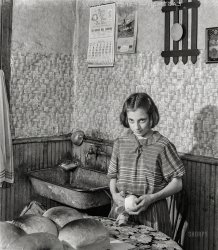
- Pinned: 1943
- ... Railroad between Argentine and Emporia, Kansas." Photo by Jack Delano for the Office of War Information. View full size.
The joy of ... Posted by Dave - 10/04/2014 - 5:07pm -
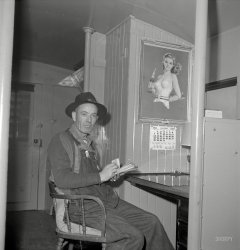
- Behemoth: 1943
- ... chat while waiting for orders to pull out." Photo by Jack Delano. View full size.
It's a big one! Engine 3014, Class H ... Posted by Dave - 12/10/2014 - 9:40am -
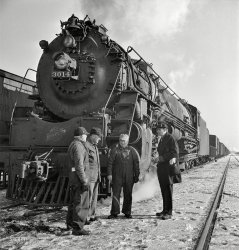
- Yesterday's Headlines: 1941
- ... support and whittled-down chair. Medium format negative by Jack Delano. View full size.
Amazing technology In the late 1970s I was ... Posted by Dave - 12/12/2018 - 9:30am -
![Yesterday's Headlines: 1941 June 1941. "Mr. Cary Williams, editor of the Greensboro Herald Journal, a newspaper in Greensboro, Georgia." Spitting hot lead at an ancient Linotype machine. Note the custom-fitted ergonomic back support and whittled-down chair. Medium format negative by Jack Delano. View full size.
Amazing technologyIn the late 1970s I was studying graphic design, and our instructor took a group of us to the offices of Sunset Magazine to see a linotype in action. The publication was just weeks away from going computerized, but the operator put on quite a show for us. There's nothing like moving parts to make work seem entertaining.
etaoin shrdluI still have-and use regularly-a Linotype machine. Also, the metal is melted and used at around 535 to 545 degrees. Less than that it won't melt properly, and much above that is when you are apt to get squirts.
The aroma is uniqueI worked in the office of a hot lead Hearst paper in Baltimore in the '70s. The building’s back stairs included a landing that was open to the pressroom, and the odor of molten lead poured into stairwell. Nothing else smells quite like that. Shorpy brought it all back to me!
Printer's DevilThis reminds me of one of my favorite Twilight Zone episodes starring Burgess Meredith as the devil masquerading as a reporter who promises to salvage a failing newspaper in exchange for the editor's soul.
LineageI believe Etaoin Shrdlu was Lorem Ipsum's grandpa.
ETAOIN SHRDLUA well-known "phrase", but I followed Dave's LMGTFY link, and was surprised not to find the reference that first came to mind -- "Etaoin Shrdlu" is the title of a 1942 short story by Fredric Brown about a sentient Linotype machine.
Etaoin shrdluIt had to be said.
Huh?Over my head this morning.
[Google it. - Dave]
ProgressEarlier this week, I ran across a story of an 8 monitor, 18 million pixel custom workstation with a sling chair that is like a modern incarnation of Mr. Williams' rig.
Hot LeadvilleIn Saguache, Colorado, there's a newspaper called the Saguache Crescent that is still produced daily on an old linotype machine.
Ah, yesterdayIn the 1960s when the Comanche (Texas) Chief was still a hot-type operation, I used to hang out in their print shop, watching Bob Carpenter set type (he was good enough as a reporter AND printman that he would sometimes compose his articles directly on the lino) and Minor Taber and Woody Ormsby run the jobbing presses.
If I hit at the right time on Thursday afternoon, I could watch the crew wind up the big rotary press to run the week's edition of the Chief; that was a special treat.
A Blast from the PastWhen I was a high school senior in Chicago I took a print shop class, where we were taught to operate a Linotype machine just like this one. It always scared the hell out of me; we were warned that if we mistakenly left an open space in one of the lines of brass keys we were assembling, molten lead at 700 degrees Fahrenheit would "squirt" in our faces. Our machines were old and cranky, and I could rarely type out more than three lines before something would jam. Now I see them on display as museum pieces ... yikes!
Spitting LinotypeI have a documentary on the Linotype. (www.linotypefilm.com) Apparently, experienced operators could hear a warning sound to back off quickly to avoid getting hit by a bit of hot lead. I got a chance in the 1960s to see a room full of them at the News Call Bulletin in San Francisco. You don't forget a mechanical wonder like that.
Family TraditionCarey Jones Williams, April 6, 1901 - July 9, 1991
Carey (with an "e") later served on the University of Georgia Board of Regents. His son Carey Jr. is the current editor (and owner) of the Greensboro Herald Journal.
Not dead yetThere's a movie: http://www.linotypefilm.com and the Linotype is so loved that there are at least two organizations in my immediate area (Waltham and Haverhill, Mass.) with one or two working units:
https://www.charlesrivermuseum.org/
https://museumofprinting.org/collection/
I love old, well built, intricate and obsolete machinery. And Real Computers have switches and blinking lights.
LinosaursBoth The Printing Museum in Houston and the Baltimore Museum of Industry have full print shops on display, and if you hit 'em on the right days a retired operator (from The Houston Chronicle or Baltimore Sun) will be there to make them sit up and talk for you.
(Technology, The Gallery, Jack Delano, The Office)](https://www.shorpy.com/files/images/SHORPY-8c05858a.thumbnail.jpg)
- Sunrise, Sunset: 1940
- ... grocer, and S. Kalmonwitz, fishmonger. 35mm negative by Jack Delano. View full size.
Then & Now In the same photo !
... Posted by Dave - 06/10/2015 - 6:46pm -
![Sunrise, Sunset: 1940 November 1940. "Jewish stores in Colchester, Connecticut." R. Goldman, grocer, and S. Kalmonwitz, fishmonger. 35mm negative by Jack Delano. View full size.
Then & NowIn the same photo!
1940 US CensusThere is a Rose Kalmonowiz living with/renting to a Benjamin and Rebecca Goldman; they both lived at 45 Lebanon Avenue. Benjamin's occupation is listed as a Grocer. Going back a decade to 1930, there is a Sam (or possibly Siam) Kalmanowitz living on Lebanon Road, with the occupation of "Fish Peddler." I'd bet decent money that Benjamin and Sam are the Goldman and Kalmaowitz from this photo.
Where's Tevye?Transliterate the Roman characters to Cyrillic, and this could be a scene from a typical Eastern European shtetl around the time of the Black Hundreds' atrocities, dirt streets and all.
Jewish stores?I am puzzled as to why the caption references the stores as "Jewish". Selling groceries (Coca Cola, Salada tea, tobacco products, fresh vegetables, Hires Root Beer, Royal Crown Cola, and fresh fish) make them Jewish? If the owners were named Rossi and Mangioni, would these , then, be "Catholic stores"?
[The photos in the Library of Congress FSA/OWI Collection come from several federal government projects whose purposes included documenting as well as publicizing the country's ethnic and cultural diversity. Overseas propaganda value was among the considerations, especially as war loomed. The captions and descriptions originally appended to the photos therefore recorded such information when it was relevant. -tterrace]
It's sunsetIt would actually be sunset given the position of the shadows and the house.
[Sunrise, Sunset. -tterrace]
Jewish farmersIn the early 20th century, the Jewish Agricultural Society in New York began an effort to establish agricultural settlements in and around Colchester, Lebanon, and Montville, Connecticut. Some of the transplants rapidly moved on to other businesses. It appears Delano (incidentally, himself a Jew) was recording this next step. A good article on the topic is here.
Re: Jewish farmersIn Canada, all immigrants were given a crack at free land via the Dominion Lands Act of 1872, the purpose of which was to populate the Prairies (as well as to prevent the land from being claimed by the neighbors to the south). For a $10 administrative fee, the immigrant would get 160 acres (a quarter-section) of free land, provided he cultivated at least 40 acres and built a permanent dwelling within three years. Many of my ancestors were lured west with this offer but ended up in small towns as shopkeepers or in cities as urban workers.
The intriguing magazine cover (below) is taken from the article Manalto links to.
(The Gallery, Jack Delano, Rural America, Stores & Markets)](https://www.shorpy.com/files/images/SHORPY-8a34664a.thumbnail.jpg)
- School Days: 1941
- ... school near Fairfield, Vermont." Medium format negative by Jack Delano. View full size.
Rural schooldays And some 30 years earlier, ... Posted by Dave - 01/24/2019 - 12:42pm -
![School Days: 1941 September 1941. "Two of the Gaynor boys walking to school near Fairfield, Vermont." Medium format negative by Jack Delano. View full size.
Rural schooldaysAnd some 30 years earlier, my Dad rode his horse to school in northern Kentucky, carrying a loaded revolver.
Lunch pailsSome people in Nebraska called it that too. I visited the Pioneer Village museum in Minden, Nebraska a couple years ago, and there was a one-room schoolhouse. In the front of the schoolhouse, there were lunch containers all lined up. There were lunch pails and cigar boxes and any other containers that school children in the old days could bring their lunch in.
Alternate SpellingI lived in Maine long ago when first married, and worked for an old-timer who called his lunch pail a Dinner Bucket.
Brilliant!Sun flash on the Lunch Bucket. Serendipity, do you think, or are there multiples of this shot trying to get it?
[Actually it's because Ma packed Billy a plutonium sandwich. - Dave]
Uphill Both WaysI'd be willing to bet that during winter they had to walk uphill both ways in the middle of a blizzard.
Beyond the PailLooking at the young man on the left, you can see where the old expresson "lunch pail" got its origin. Lunch was actually packed in a small bucket or pail. It had a handle, was sturdy and leakproof.
Maybe the term lunch pail was a regionalism, but it was popular in my area, especially among factory workers.
(The Gallery, Jack Delano, Kids, Rural America)](https://www.shorpy.com/files/images/SHORPY-8c06951a1.thumbnail.jpg)
- Snowy Joliet: 1943
- ... the Atchison, Topeka & Santa Fe railyard." Photo by Jack Delano for the Office of War Information. View full size.
Can't ... Posted by Dave - 12/24/2014 - 10:50am -
![Snowy Joliet: 1943 March 1943. "Joliet, Illinois. Leaving the Atchison, Topeka & Santa Fe railyard." Photo by Jack Delano for the Office of War Information. View full size.
Can't quite make it outKeep the door closed when ??????????? cars.
[Illegible in the original. -tterrace]
Sign, sign, everywhere a signMy take:
KEEP THIS DOOR
CLOSED WHEN NOT
WEIGHING CARS
Mixed Signals?That looks like a train order signal. Not motorized, each blade appears to be manually operated by means of a pipe that extends down each side of the mast to just above the ground and then... nowhere. No trackside racks for delivering orders/messages on the fly, no telegraph office visible... are there any Santa Fe experts out there who know what this signal might have been for?
WestboundMr. Delano was looking back from the caboose of a westbound train; the view is actually NNE. Des Plaines River/Sanitary and Ship Canal to the left, EJ&E bridge and Joliet Coke Plant in the background.
The Scale HouseAn important ancillary building once found in nearly every yard, but now less common, was the scale house.
Most cars containing bulk commodities such as grain, coal, and such were weighed - both to determine the weight for transportation charges by the railroad, and often for the charges the shipper would bill their customer for the merchandise. Every car had (has) the empty weight of the car stenciled on the side of the car, and the switching crew and a clerk would weigh each car, and subtract the Lt Wt (Light Weight, as stenciled) to determine the weight of the contents, and attach the scale ticket to the Bill of Lading.
Note that there are four rails past the scale house. The Live Rails were for weighing the cars, the Dead Rails (or Bypass Rails) were so that engines could pass the scale without using the Live Rails, since their weight often exceeded the capacity of the scale.
(The Gallery, Jack Delano, Railroads)](https://www.shorpy.com/files/images/SHORPY-8d26313u.thumbnail.jpg)
- Class Struggle: 1940
- ... The teacher is Miss Holmes." Medium format negative by Jack Delano. View full size.
Eyes are on the Ruler. And she probably ... Posted by Dave - 01/11/2019 - 10:11pm -
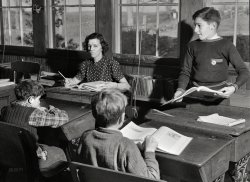
- Message Received: 1943
- ... Topeka & Santa Fe between Belen and Gallup." Photo by Jack Delano for the Office of War Information. View full size.
Clarence W ... Posted by Dave - 06/06/2015 - 1:10pm -
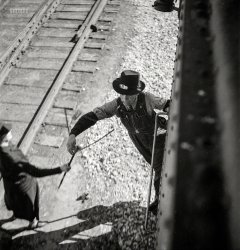
- Glass House: 1941
- ... glass works in background." Medium format negative by Jack Delano for the Farm Security Administration. View full size.
A ... Posted by Dave - 12/26/2018 - 12:16pm -
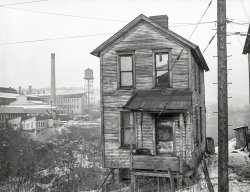
- Everything Must Go: 1941
- ... to be taken over by the Army." Medium format negative by Jack Delano. View full size.
Close to Home I'm a Navy reservist whose ... Posted by Dave - 03/13/2019 - 10:30am -
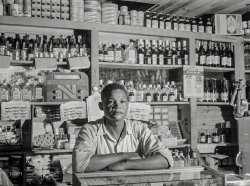
- Country Barber: 1941
- ... shop in Centralhatchee, Heard County, Georgia." Photo by Jack Delano for the Farm Security Administration. View full size.
Maybe ... Posted by Dave - 06/28/2021 - 4:35pm -
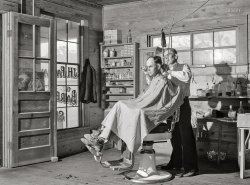
- Lunch With Elibia: 1943
- ... View full size. 4x5 Kodachrome transparency by Jack Delano for the Office of War Information.
Elibia's Lunch I believe ... Posted by Dave - 08/30/2012 - 3:31pm -
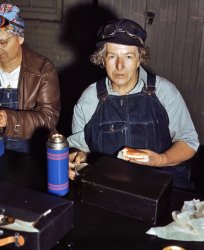
- Two-Cent Cigars: 1942
- ... and sell for about two cents." Medium format negative by Jack Delano for the Farm Security Administration. View full size.
Vapor ... Posted by Dave - 03/28/2019 - 3:57pm -
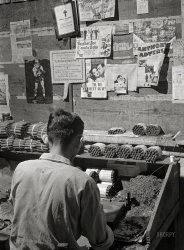
- Grill Noir: 1940
- ... George's Grill, open all night. 35mm nitrate negative by Jack Delano. View full size.
Curb Service A term I've never heard of, can ... Posted by Dave - 08/05/2014 - 9:35am -
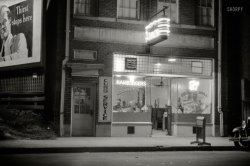
- Enosburg Falls: 1941
- ... passing through Enosburg Falls." Medium format negative by Jack Delano. View full size.
De-railed The tracks have all been ripped up ... Posted by Dave - 01/31/2019 - 9:58pm -
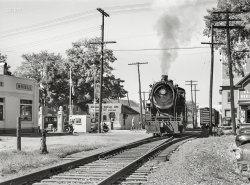
- The Family Bus: 1941
- ... near South Rutland, New York." Medium format negative by Jack Delano. View full size.
Curious Anyone know what the function of the ... Posted by Dave - 02/01/2019 - 8:04pm -
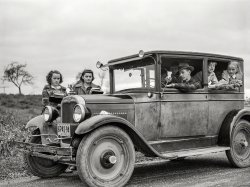
- Kids in the Hall: 1940
- ... in Beaver Falls, Pennsylvania." Medium format negative by Jack Delano. View full size.
Crackerbox Interesting - I don't know the ... Posted by Dave - 11/08/2018 - 10:42am -
![Kids in the Hall: 1940 January 1940. "Tenants living in a crackerbox. Slum tenement in Beaver Falls, Pennsylvania." Medium format negative by Jack Delano. View full size.
CrackerboxInteresting - I don't know the nuances of the term and it's not widely used in my experience, but I always thought of a crackerbox as a small, single family type home. This appears to be a tenement building of some sort.
[As stated in the caption. - Dave]
Yes but those are contradictory terms to my understanding.
Far from Broadway Beaver Falls, Joe Namath's hometown.
Bad landlordOwners, or even renters with a good landlord, would have swept away those cobwebs and swept the floor.
I am also always stunned by the beauty of tenements. Yes, they were deathtraps, yes, they were tiny and disease ridden, but by golly, they knew how to do woodwork around that plaster.
Icebox in the HallI have one EXACTLY like that sitting out in the garage.
ZappCan't quite figure out what the collection of overhead wiring is all about, but I wonder if it has anything to do with the dark fan-like marks where the wall meets the ceiling.
[You are looking at cobwebs and clotheslines. - Dave]
Head slap: Of course, me bad.
(The Gallery, Jack Delano, Kids)](https://www.shorpy.com/files/images/SHORPY-8c04420a.thumbnail.jpg)
- Tower B: 1943
- ... hump. View full size. 4x5 Kodachrome transparency by Jack Delano.
Cleanest hands in the railyard Love that sweater/jacket!
... Posted by Dave - 08/30/2012 - 2:00pm -
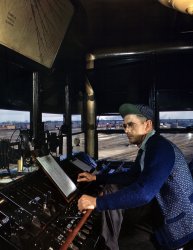
- Ready to Roll: 1943
- ... Atchison, Topeka and Santa Fe yard." Nitrate negative by Jack Delano. View full size.
The Wheels Were Always Waiting. These guys ... Posted by Dave - 08/05/2012 - 1:12pm -
![Ready to Roll: 1943 March 1943. Barstow, California. "Head brakeman J.C. Shannon (left) and swing brakeman B.E. Wilson waiting for their train to pull out of the Atchison, Topeka and Santa Fe yard." Nitrate negative by Jack Delano. View full size.
The Wheels Were Always Waiting.These guys were tough!
Getting on one of those tanks on the move at night in the rain, sleet or blowing snow by the light of a coal oil lamp was a challenge.
Sort of a grasping leap in harmony with the moving train. Footing impeded with sloped ballast edge or deep snow while carrying the lamp, which would go 'out' if roughly handled.
You had only one chance! on a moving tank.
If your boot heel slipped beyond the stirrup you could feel the wheel rubbing against it just waiting to carve you to bits if your hands slipped and you pivoted under and fell.
Flat cars were worse to board, with less to grab.
The Engineer could never stop in time, if he even saw you slip and fall far back in the train, the tonnage pushing.
No radios, then.
If you had to 'walk' the top of the train to relay hand signals, set up or take down retainers or apply hand brakes, when required by whistle signal, you climbed down to the tanks from the boxcars and went around the outside of the tank on the wooden running board holding on to the hand rail pipe at speed.
The tops of the high cars rocked back and forth sideways in answer to the staggered rail joints under the wheels, and it was often better to run than walk, jumping car-to-car, with a long fall to the waiting wheels below.
Ice and snow made this a challenge, rain too, or if the catwalks were slippy with oil from an oil-fired engine or a new Diesel's exhaust.
Too old to go back, and glad of it.
Thank You.
BarstowMy hometown.
Life imitating art?That could be a still from a movie starring the young Spencer Tracy and Charles something (I keep forgetting the name).
[Bickford? Laughton? Ruggles? Butterworth?]
Charles Laughton, I think. Thanks for the pointers!
A moments respiteAs a former yard brakeman, this brings back the memories of a few quiet moments waiting for someone else to do their work and get out of our way. That tank car was not only a nice place to sit, but it had a two step stirrup with a high running board, making it a much easier car to get on of off than many tanks and flats. The Nickel Plate Road safety officer always discouraged our trying to get on or off this type of car while it was in motion. Maybe that little advice contributed to our being a Harriman Safety Award winner so often.
Since the air hoses between the tank and box car are not connected, there is still some work to do before this cut becomes part of a train. But the guys shown here certainly have the wherewithal to assemble it.
InitialsPerhaps one of you old railroaders could refresh my memory on this. Several years ago my daughter bought me a wonderful coffee table photo book that was comprised of all night photos of steam trains in Virginia (I believe). In the book they noted the tradition of railroaders using initials instead of names. Thoughts?
[Possibly O. Winston Link's Ghost Trains or Steam Steel and Stars]
Yes, I believe that it is indeed Steam, Steel, and Stars!
Brakeman in 1943?KC Ry.,
Your account of a brakeman is accurate, in the days before Westinghouse Air Brakes, pre-1893. In the photo I see brake shoes on the tank car, and an air line between the cars.
Q - What then was the role of a Brakeman in 1943? Setting of brakes when cars were uncoupled?
Jack Delano RR photos are always enjoyable.
GraffitiGee, where is all the "beautiful" spray-can artwork that adorns out present-day rail stock? Although I am an artist, I can't stand this vandalism. Not only a waste of paint, but detrimental to the environment. The photo looks like source material for one of Norman Rockwell's cover projects.
(The Gallery, Jack Delano, Railroads)](https://www.shorpy.com/files/images/8d27524u.thumbnail.jpg)
- Go Right: 1940
- ... in Colchester, Connecticut." Medium format negative by Jack Delano for the Farm Security Administration. View full size.
Has ... Posted by Dave - 01/11/2019 - 4:34pm -
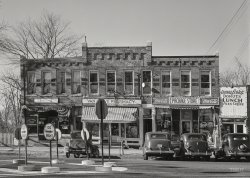
- Socks Workers: 1941
- ... Greene County, Georgia." Medium format acetate negative by Jack Delano. View full size.
Chipman Union hosiery mill Probably at the ... Posted by Dave - 02/18/2019 - 9:40pm -
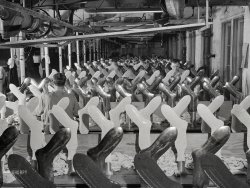
- Roy Nelin: 1942
- ... R.R. View full size. 4x5 Kodachrome transparency by Jack Delano for the Office of War Information.
Rockwell There's a very Norman ... Posted by Dave - 08/30/2012 - 2:02pm -
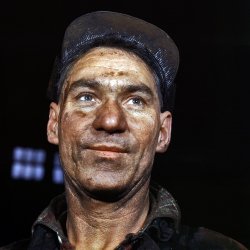
- Store Noir: 1940
- ... 11 p.m. Durham, North Carolina." Medium format negative by Jack Delano for the Farm Security Administration. View full size.
Spirits ... Posted by Dave - 11/06/2018 - 4:12pm -
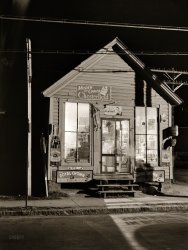
- Pine Camp: 1941
- ... Camp expansion area." Medium format acetate negative by Jack Delano. View full size.
Now Fort Drum When I was a kid my dad used ... Posted by Dave - 06/16/2021 - 8:56am -
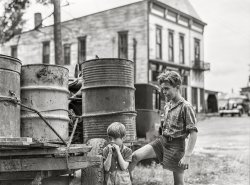
- Man-Cave Caboose: 1943
- ... take back from division points." Medium-format negative by Jack Delano for the Office of War Information. View full size.
Pinups ... Posted by Dave - 10/21/2013 - 10:25am -
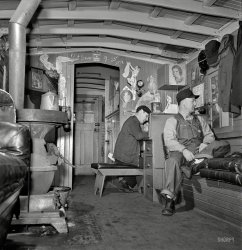
- Track Crew: 1942
- ... at the Illinois Central rail yard, Chicago." Photo by Jack Delano for the OWI. View full size.
Watermark I just noticed the ... Posted by Dave - 08/02/2015 - 1:05pm -
![Track Crew: 1942 November 1942. "Track crews repairing tracks in the roundhouse at the Illinois Central rail yard, Chicago." Photo by Jack Delano for the OWI. View full size.
WatermarkI just noticed the faint watermark in this image. Is this something new, or have I just not been very observant when looking at past images?
[Not very observant. - Dave]
Mountains in IllinoisThe tenders poking out of the roundhouse all belong to IC 2500-class 4-8-2 "Mountain" types. These locomotives were built in IC's own shops, re-using the boilers of some earlier Lima-built 2-10-2 types. Capable in either freight or passenger service, they lasted until the end of steam on IC. Here's a good look at one:
Which roundhouse?Which roundhouse was this? Did IC have any others in Chicago besides 27th Street?
(The Gallery, Chicago, Jack Delano, Railroads)](https://www.shorpy.com/files/images/SHORPY-8d23260a.thumbnail.jpg)























